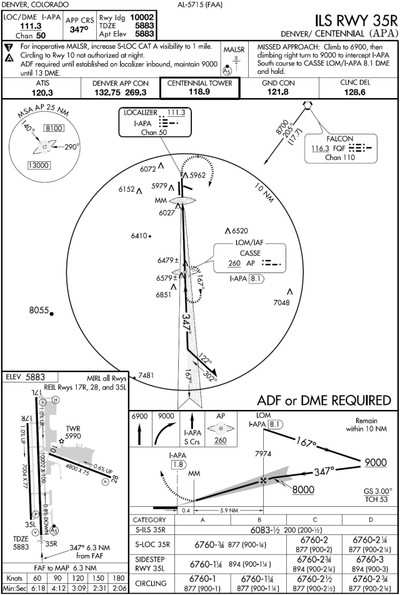Pilot Received Warning Of Low-Altitude Too Late
 The NTSB says the August 2005
crash of Mitsubishi MU-2 while attempting a night approach to
Centennial Airport (APA), near Denver, CO was the result of
controlled flight into terrain.
The NTSB says the August 2005
crash of Mitsubishi MU-2 while attempting a night approach to
Centennial Airport (APA), near Denver, CO was the result of
controlled flight into terrain.
The commercially-rated pilot, Sam Hunter, was attempting the ILS
Rwy 35R approach during night IMC. Hunter received radar vectors to
final and a clearance to maintain 8,000 feet MSL until established
on the localizer.
When four miles from the final approach fix, he was passed off
to Centennial Tower. At 02:04:46 he attempted to contact the tower
but received no response. His second attempt 30 seconds later was
successful and he received a clearance to land. The pilot's
acknowledgement of his landing clearance was the last recorded
communication from the aircraft.
Radar data reveals the aircraft steadily descending below the
glidepath while tracking the localizer inbound.
At 02:06:40 the tower controller alerted the pilot to ""...check
altitude...your altitude indicates six thousand four hundred...you
appear to be well below the glide slope." The pilot did not
respond. The tower controller then made several attempts to contact
the pilot but there was no response.
The last radar return shows the aircraft approximately four
miles south of the landing threshold at 6,400 MSL holding 140 knots
groundspeed. The aircraft crashed at night in a remote area --
there were no witnesses.
Weather reported at 02:11, was wind from 010 degrees at 7 knots,
visibility 3 statute miles, rain, mist, scattered clouds at 700
feet, broken clouds at 1,200 feet, overcast at 2,200 feet,
temperature 15 degrees Fahrenheit, dew point 14 degrees Fahrenheit,
and a barometric pressure setting of 30.38 inches of Mercury. The
tower visibility was reported as 4 statute miles.

A reconstruction of the accident sequence revealed Hunter began
descending below the glideslope on the ILS after his hand off to
the tower -- while he was still eight miles from the runway. At
02:05:37, the Denver TRACON Minimum Safe Altitude Warning (MSAW)
visual alert and aural alarm activated for about 5 seconds and
again from 02:06:00 until terrain impact about 42 seconds later.
The airplane was about 7.2 and 6.3 nm from the airport,
respectively, when the MSAW alerts at Denver TRACON activated.
Because of the MSAW software configuration at Denver TRACON,
Centennial Tower was not eligible to receive aural MSAW alarms for
any aircraft more than 5 nm from the airport. As a result, the
controller at Centennial Tower only received visual alerts until
the aircraft reached 5 nm from the airport. Tower
controllers are not encouraged to actively monitor the visual
display as their attention should be primarily outside the cab on
the runway environment.
When the airplane reached a point 5 nm from Centennial Airport
at 0206:35, the ongoing MSAW alarm generating a visual
alert on the tower display then triggered the aural
alarm in the tower. The tower controller immediately transmitted a
low altitude alert to the pilot, but the airplane impacted terrain
within seconds.
A previous FAA order had relieved the TRACON of any
responsibility to transmit an MSAW alert for approaching aircraft
once handed off to the tower. The radar controller stated she
thought the tower MSAW alarm extended to 10 miles out.
The NTSB determined the probable cause of the accident to be the
pilot’s failure to fly a stabilized instrument approach at
night which resulted in controlled flight into terrain.
Contributing factors were the dark night, low clouds, the
inadequate design and function of the airport facility’s
Minimum Safe Altitude Warning System (MSAW), and the FAA’s
inadequate procedure for updating information to ATC
controllers.
 ANN's Daily Aero-Linx (04.16.24)
ANN's Daily Aero-Linx (04.16.24) Aero-News: Quote of the Day (04.16.24)
Aero-News: Quote of the Day (04.16.24) Airborne 04.10.24: SnF24!, A50 Heritage Reveal, HeliCycle!, Montaer MC-01
Airborne 04.10.24: SnF24!, A50 Heritage Reveal, HeliCycle!, Montaer MC-01 Airborne 04.12.24: SnF24!, G100UL Is Here, Holy Micro, Plane Tags
Airborne 04.12.24: SnF24!, G100UL Is Here, Holy Micro, Plane Tags Airborne-Flight Training 04.17.24: Feds Need Controllers, Spirit Delay, Redbird
Airborne-Flight Training 04.17.24: Feds Need Controllers, Spirit Delay, Redbird




